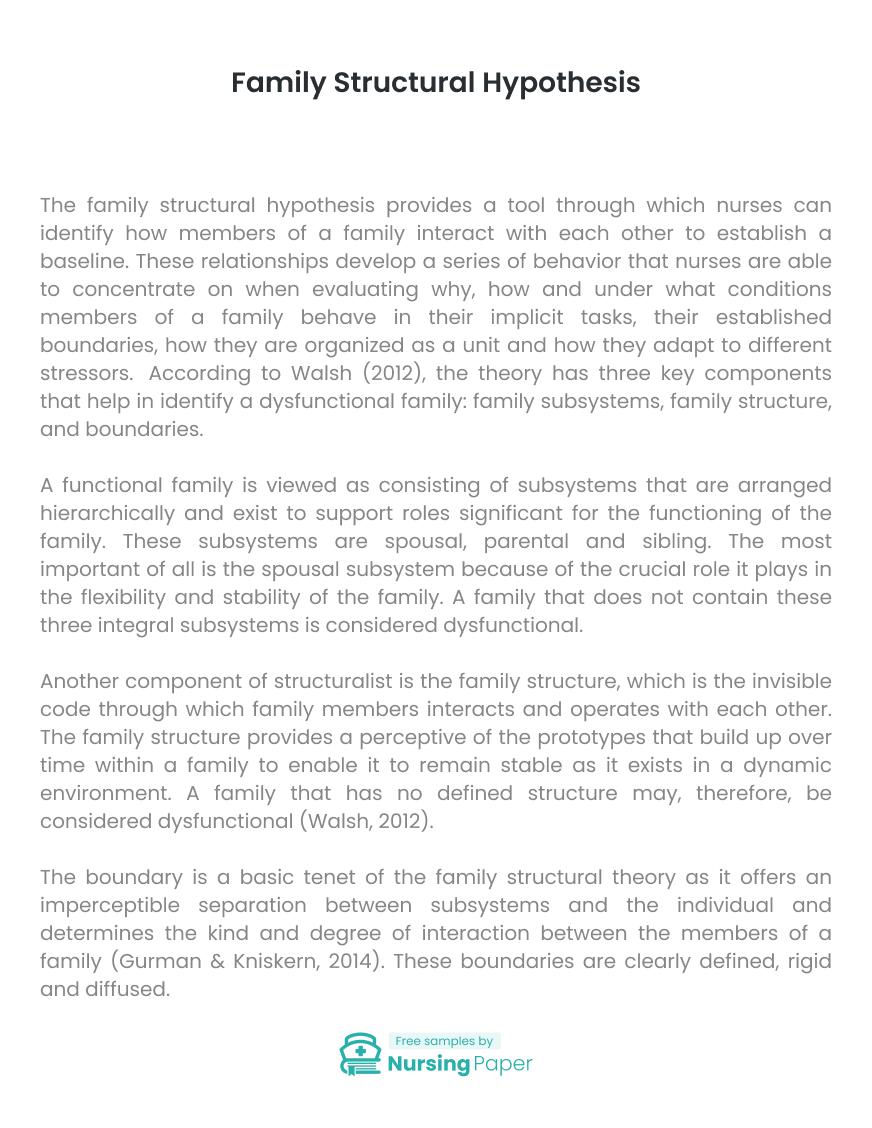
Introduction
The family structural hypothesis provides a tool through which nurses can identify how members of a family interact with each other to establish a baseline. These relationships develop a series of behavior that nurses are able to concentrate on when evaluating why, how and under what conditions members of a family behave in their implicit tasks, their established boundaries, how they are organized as a unit and how they adapt to different stressors. According to Walsh (2012), the theory has three key components that help in identify a dysfunctional family: family subsystems, family structure, and boundaries.
A functional family is viewed as consisting of subsystems that are arranged hierarchically and exist to support roles significant for the functioning of the family. These subsystems are spousal, parental and sibling. The most important of all is the spousal subsystem because of the crucial role it plays in the flexibility and stability of the family. A family that does not contain these three integral subsystems is considered dysfunctional.


Another component of structuralist is the family structure, which is the invisible code through which family members interacts and operates with each other. The family structure provides a perceptive of the prototypes that build up over time within a family to enable it to remain stable as it exists in a dynamic environment. A family that has no defined structure may, therefore, be considered dysfunctional (Walsh, 2012).
The boundary is a basic tenet of the family structural theory as it offers an imperceptible separation between subsystems and the individual and determines the kind and degree of interaction between the members of a family (Gurman & Kniskern, 2014). These boundaries are clearly defined, rigid and diffused. A dysfunctional family has diffused edges which result in blurred demarcation lines between subsystems. The ultimate result of this is disengagement or isolation.
1. Gurman, A. S., & Kniskern, D. P. (2014). Handbook of family therapy. Lonndon: Routledge.
2. Walsh, F. (2012). Clinical views of family normality, health, and dysfunction. Normal family processes: Growing diversity and complexity, 28-54. Retrieved from http://www.drkeithsutton.com/home/drkeithsutton/Walsh%20F%20%20NormalFamilyProcesses%204e%20Ch%20%202%20.pdf



The download will start shortly.

The download will start shortly.
 Subject:
Health and Social Care
Subject:
Health and Social Care  Number of pages: 2
Number of pages: 2  Subject:
Nursing
Subject:
Nursing  Number of pages: 2
Number of pages: 2  Subject:
Health and Social Care
Subject:
Health and Social Care  Number of pages: 4
Number of pages: 4  Subject:
Medicine
Subject:
Medicine  Number of pages: 8
Number of pages: 8  Subject:
Nursing
Subject:
Nursing  Number of pages: 2
Number of pages: 2  Subject:
Medicine
Subject:
Medicine  Number of pages: 6
Number of pages: 6  Subject:
Nursing
Subject:
Nursing  Number of pages: 3
Number of pages: 3  Subject:
Medicine
Subject:
Medicine  Number of pages: 5
Number of pages: 5  Subject:
Medicine
Subject:
Medicine  Number of pages: 6
Number of pages: 6  Subject:
Nursing
Subject:
Nursing  Number of pages: 6
Number of pages: 6  Subject:
Medicine
Subject:
Medicine  Number of pages: 8
Number of pages: 8  Subject:
Nursing
Subject:
Nursing  Number of pages: 3
Number of pages: 3  Subject:
Nursing
Subject:
Nursing  Number of pages: 2
Number of pages: 2  Subject:
Nursing
Subject:
Nursing  Number of pages: 2
Number of pages: 2  Subject:
Medicine
Subject:
Medicine  Number of pages: 4
Number of pages: 4 
